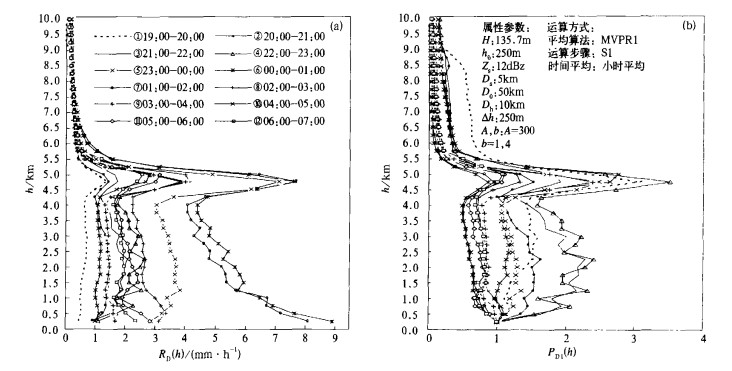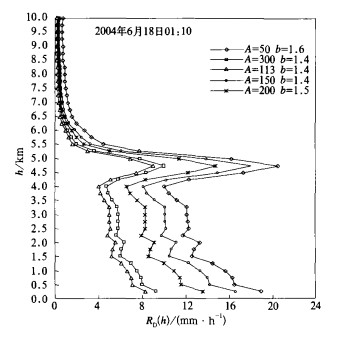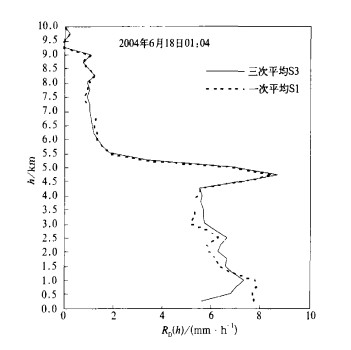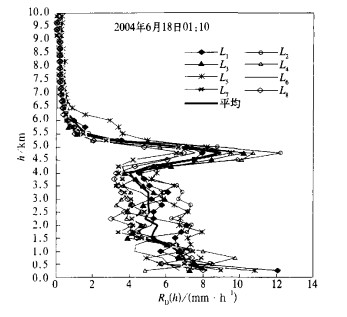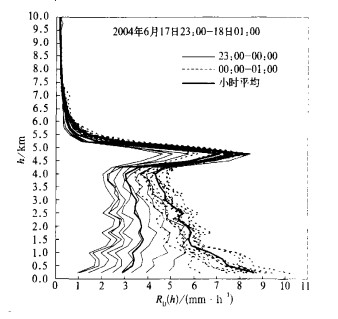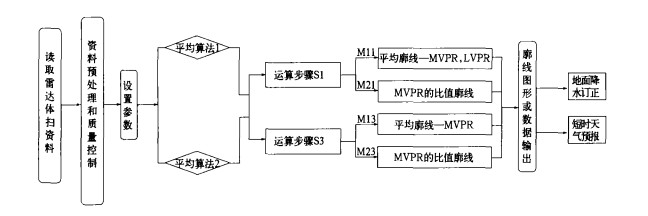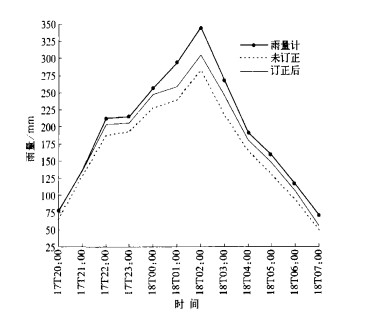雷达回波垂直廓线及其生成方法
Vertical Profile of Radar Echo and Its Deteermination Methods
-
摘要: 研究雷达回波Z (R) 垂直廓线VPR有两个重要内容: 一是VPR的生成方法, 二是用VPR订正雷达估算降水的技术。在简要比较现有生成方法———参数法、平均法和识别法的主要特点后, 认为平均垂直廓线MVPR具有简便、实用的优点。文章着重对MVPR的生成方法作了细致的探讨, 形成了4种生成算法, 并作了比较; 展示了各种生成参数对MVPR的不同作用, 并简要介绍了一个应用程序框图。对两个降水实例实施订正后初步评估表明, 用MVPR订正雷达估算降水可使评估因子R/G从0.84 (0.86) 提高到0.93 (0.97), 而绝对误差率则下降4%。Abstract: Radar beam's lifting and widening in the distance and the vertical nonuniformity of the natural distribution of water content in the atmosphere are important factors of radar detecting rainfall errors. During 1980s—1990s, the importance of vertical profile of reflectivity (VPR) to radar detecting rainfall is emphasized and the study on the VPR technology is conducted. There are two major aspects on the researches of VPR, one is the determination method of VPR, the other is the technique to correct radar precipitation estimation. After comparing the major features of three existing determination methods, i.e., parameterization, averaging and identification, it is found that the mean vertical profile of reflectivity (MVPR) has the advantage of simplicity and utility. Four algorithms of MVPR are obtained and compared with emphasis on investigating the determination method for mean vertical profile (MVPR); and the different functions of determining parameters, especially for MVPR, are demonstrated. Results show that the R/G ratio can be enhanced from 0.84 (0.86) to 0.93 (0.97) and the AD of radar rainfall estimation can decrease by 4% after the MVPR correction in the two precipitation cases.Among the four algorithms of MVPR, M11 is the best one in which the ratio profile takes the near groundlevel as the datum plane so that the feasibility of radar precipitation correction can be assured, and it has better representation owing to consideration of the same weighing of each bin in domain D. The MVPR algorithms relate to 8 attribute parameters, of which some values exert significant effect on the quality of MVPR. For example, the initial distance Ds in domain D obviously affects the profile shape below 1 km, therefore 1~5 km should be adopted; the distance outside D0 domain D plays its role from near ground-level to 6 km and the smaller D0, the smaller the more smoothing due to the beam widening, so 40~50 km should be adopted; the smaller the value of the vertical piecewise-height Δh, the more detailed the profile shape, so 250 m should be adopted. The evidence also indicates that when the exponent b in the different Z-R relationships are kept constant, the slope of the profile below 1.5 km will increases and the bright band of the profile will be more distinguishable with the decrease of the coefficient A.By analyzing VPR derived from the volume data in terms of VCP21 model of CINRAD/SA in Wuhan, it is found that the bright band locates at the height of 5 km and the radar precipitation estimation is generally not affected by the bright band when using 0.5° reflectivity PPI (or hybrid scan) within radius of 200 km. When echoes of major precipitation system in domain D, Z (R) below the bright band decreases with the height (dZ/ dh < 0), and these may be the causes why radars underestimate summer rainfall (especially for long distance) in the middle reaches of the Yangtze and it could be done by means of VPR to correct the radar precipitation estimation.
-
表 1 MVPR的生成属性参数

表 2 MVPR的运算方式

-
[1] Joss J, Waldvogel A. Precipitation Measurement and Hydrology∥Atlas D. Radar in Meteorology: Battan Memorial and 40th Anniversary, 1990: 577-606. [2] Koistinen J. Operational Correction of Radar Rainfall Errors due to the Vertical Reflectivity Profile. 25th Int Radar Meteor Conf, AMS, 1991: 91-94. [3] Joss J, Lee R. The application of radar-gauge comparisons to operational precipitation profile corrections. J Appl Meteor, 1995, 34: 2612-2630. doi: 10.1175/1520-0450(1995)034<2612:TAORCT>2.0.CO;2 [4] Kitchen M, Brown R, Davies A G. Real-time correction of weather radar data for the effects of bright band, range and orographic growth in widespread precipitation. Q J R Meteorol Soc, 1994, 120: 1231-1254. doi: 10.1002/(ISSN)1477-870X [5] Andrieu H, Creutin J D. Identification of vertical profiles of radar reflectivity for hydrological applications using an inverse method. Part1: Formulation. J Appl Meteor, 1995, 34: 225-239. doi: 10.1175/1520-0450(1995)034<0225:IOVPOR>2.0.CO;2 [6] Smyth T J, Illingworth A J. Radar estimates of rainfall rates at the ground in bright band and non-bright ban events. Q J R Meteorl Soc, 1998, 124: 2417-2434. doi: 10.1002/(ISSN)1477-870X [7] Vignal B, Andrieu H, Creutin J D. Identification of vertical profiles of reflectivity from volume scan radar data. J Appl Meteor, 1999, 38: 1214-1228. doi: 10.1175/1520-0450(1999)038<1214:IOVPOR>2.0.CO;2 [8] Vignal B, Galli G, Joss Jet al. Three methods to determine profiles of reflectivity from volumetric radar data to correct precipitation estimates. J Appl Meteor, 2000, 39: 1715-1726. doi: 10.1175/1520-0450-39.10.1715 [9] Vignal B, Krajewski W. Large-Sample evaluation of two methods to correct range-dependent error for WSR-88D rainfall estimates. J Hydrometeor, 2001, 2: 490-504. doi: 10.1175/1525-7541(2001)002<0490:LSEOTM>2.0.CO;2 [10] Seo D J, Breidenbach J, Fulton R, et al. Real-time adjustment of range-dependent biases in WSR-88D rainfall estimates due to nonuniform vertical profile of reflectivity. J Hydrometeor, 2000, 1: 222-240. doi: 10.1175/1525-7541(2000)001<0222:RTAORD>2.0.CO;2 [11] Germann U, Joss J. Mesobeta profiles to extrapolate radar precipitation measurements above the Alps to the ground level. J Appl Meteor, 2002, 41: 542-557. doi: 10.1175/1520-0450(2002)041<0542:MPTERP>2.0.CO;2 [12] Berne A, Delrieu G, Andrieu H, et al. Influence of the vertical profile of reflectivity on radar-estimated rain rates at sgort time steps. J Hydrometeor, 2004, 5: 296-310. doi: 10.1175/1525-7541(2004)005<0296:IOTVPO>2.0.CO;2 [13] 史锐, 程明虎, 崔哲虎, 等.用雷达反射率因子垂直廓线联合雨量计估测夏季区域强降水.应用气象学报, 2005, 16 (6): 473-477. http://qikan.camscma.cn/jams/ch/reader/view_abstract.aspx?file_no=20050696&flag=1 [14] Klazura G, Kelly D S. A Comparision of High Resolution Rainfall Accumulation Estimation from the WSR-88D Precipitation Algorithm with Rain Gage Data. 27th Int Radar Meteor Conf, AMS, 1995: 31-34. -


 设为首页
设为首页 加入收藏
加入收藏



 下载:
下载:
